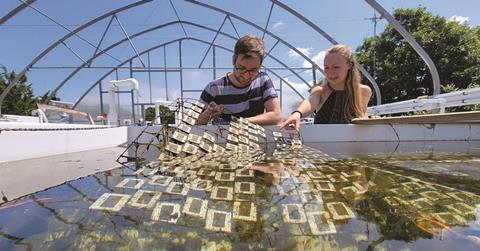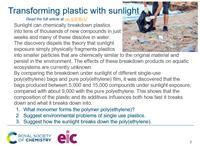How sunlight is turning single-use plastics into thousands of new compounds
A one-slide summary of this article with questions to use with your 14–16 students: rsc.li/3az989B
Sunlight can chemically breakdown plastics into tens of thousands of new compounds in just weeks and many of these dissolve in water. This discovery dispels the prevalent theory that sunlight exposure simply physically fragments macroplastics into microplastics in the marine environment, turning them into smaller particles that are chemically similar to the original material and that persist in the environment.
Researchers led by the Woods Hole Oceanographic Institution (WHOI) examined the breakdown under sunlight of different single-use poly(ethylene) plastic bags and compared them to pure poly(ethylene) film. After using a mass spectrometer equipped with a 21-tesla magnet to analyse the resultant organic compounds, the team discovered that the bags produced between 5000 and 15,000 compounds under sunlight exposure, compared with about 9000 with the pure poly(ethylene).

The researchers emphasise the importance of considering not only the fate and impacts of the initial plastics that end up in the environment, but also the transformation of those materials. They note that the effects of these breakdown products on aquatic ecosystems or biogeochemical processes, like carbon cycling, are currently unknown.
Another important finding from this study is that the composition of the plastic and its additives influences both how fast it breaks down and what it breaks down into when exposed to sunlight.
Read the full story in Chemistry World.
Put this in context
Add context and highlight diverse careers with our short career videos showing how chemistry is making a difference and let your learners be inspired by chemists like Celine, an analytical technician working in plastics.
Downloads
EiC starter slide transforming plastic with sunlight
Presentation | PowerPoint, Size 1.49 mbEiC starter slide transforming plastic with sunlight
Presentation | PDF, Size 0.27 mb










1 Reader's comment